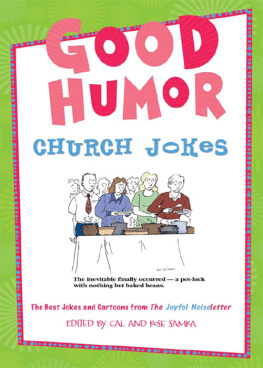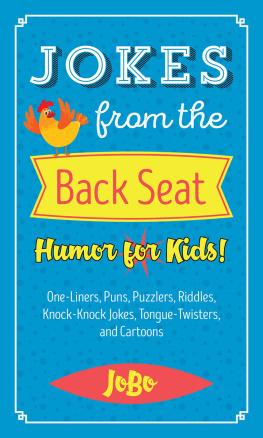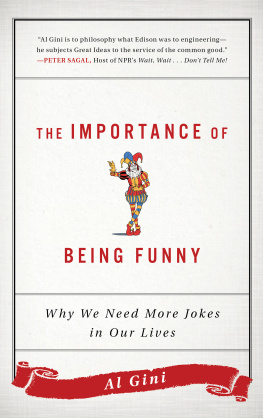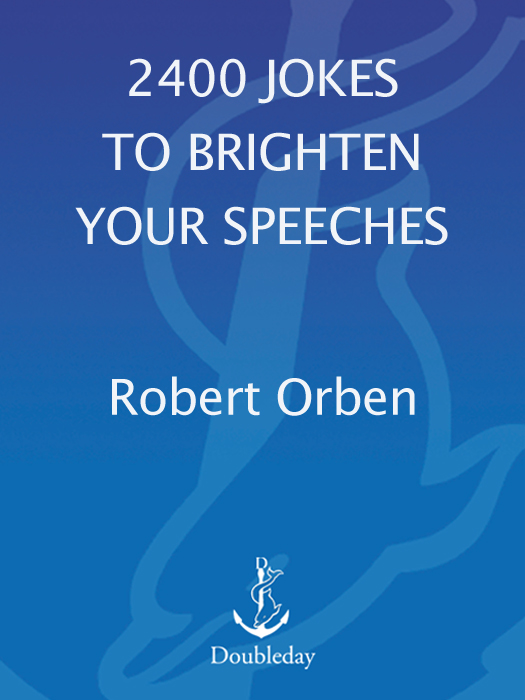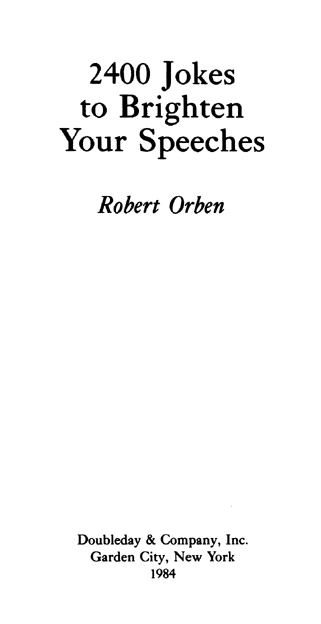Also by Robert Orben
2100 LAUGHS FOR ALL OCCASIONS
2500 JOKES TO START EM LAUGHING
THE ENCYCLOPEDIA OF ONE-LINER COMEDY
THE AD-LIBBERS HANDBOOK
THE JOKE-TELLERS HANDBOOK
ORBENS CURRENT COMEDY
(a topical humor service for public speakers)
Library of Congress Cataloging in Publication Data
Orben, Robert.
2400 jokes to brighten your speeches.
1. Public speaking. 2. American wit and humor. I. Title. II. Title: Twenty-four hundred jokes to brighten your speeches.
PN4193.I5737 1984 818.5402 8325392
eISBN: 978-0-307-81759-4
Copyright 1976, 1977, 1978, 1979, 1980, 1981, 1984 by Robert Orben
All Rights Reserved
v3.1
CONTENTS
A
B
C
D
E
F
G
H
I
J
L
M
N
O
P
R
S
T
U
V
W
X
Z
INTRODUCTION
What are the odds? Its a frequently asked question. Its perfectly normal to consider the risk-reward ratio in any new undertaking. What are the odds on a horse winning, a candidate being elected, a stock going up, a business succeeding? We weigh the evidence and then act accordingly.
So what are the odds on getting a laugh? If youre sold on the use of humor in communication, beware the tendency to be oversold. While humor can lighten and enlighten a situationit may not be appropriate in every situation. The sensitive communicator should weigh the humor pros and cons of every speaking engagement. Its one way to keep your cream of wit from curdling.
First, lets consider the time of day. Ive found that the chances of getting a laugh improve as the day grows older. Despite rumors to the contrary, most of us are imbued with the work ethic. Early in the morning there is an inbred motivation to get things moving, to accomplish. But humor calls for a certain amount of playfulness and relaxation. And so humor is a hard commodity to sell at breakfast meetings and midmorning events.
There are exceptions. If a joke is relevant and speaks to a common concern, it can work even at sunrise. I attended a breakfast at which President Ford was the speaker. The man who introduced him said that in his own military career, in World War II, he had spent four years getting up before the crack of dawn. And it wasnt his favorite hour. And so he vowed that when he got out of the army it would take the President of the United States to ever get him up at six oclock in the morning again. A pause and then he added, Its six oclock. Ladies and gentlemen, the President of the United States! Everybody in the room could relate to the thought and it worked. And so, if you have something thats right on the button for the time, the event, and the audienceyou can get laughs from an early morning group. But its much more of a challenge than later in the day.
Luncheon meetings and midafternoon sessions are worlds better for humor. The day is half over. Some amount of work has been completed. The trauma of commerce has been soothed by a 3-to-1 martini lunch. People are more receptive to fun and more willing to reward themselves with the luxury of a laugh.
But the best time of all is dinnertime and the evening hours. The battles of the day have been foughtand either won or lostbut, for the time being, theyre over. People lean back and want to savor the things that make them feel good.
Laughter is one of them. Providing the Happy Hour is just happy and not uproarious, dinners and banquets are ideal vehicles for humor. We are conditioned to look on the evening as our time to enjoy. Dinner is served at eight. Serve the humor soon after.
The one storm warning to be aware of: the evening event that goes on too long. Weve all sat through them. Theyre fun from seven to nine. Pleasant from nine to eleven. Torture from eleven to midnight. At every evening event there is a psychologically optimum time to pack up the table tents and go home. If the program goes beyond this, even if youve prepared the funniest remarks and sagest speech evertis best to throw in the towel and cut both your time and losses. Say something like Ive been sitting up here so long, the spotlight has faded my suit. Conclude with a sixty-second update of your speech and then lead the rush to the door. Youll be the hit of the evening.
Another important factor in the success of humor is the physical setting of the meeting or dinner. Get as close to the audience as possible. If the lectern is set far back from the first row of seats or tables, move it up. If you cant move it, work in front of it. Humor calls for involvementattachment rather than detachment. What you are striving for is a one-to-one, eye-contact relationship with every member of the audience.
Some meeting planners either lose sight of the need for a physically close relationship between speaker and listeneror accept imposed conditions that make such a relationship difficult. A group of 200 in a meeting room that seats 500 is bad news. You just walk into that room and you sense failure. Two hundred may be the most attendees theyve ever had, but in a room that holds 500 the audience looks like a quota that hasnt been met.
Further, laughter is a social exercise. If you hear the person next to you laughing out loud, you are more apt to do the same. And so its important that your room be just big enough to encompass your groupand the number of chairs available just enough to seat them. Better to scrounge for more chairs from another location if they are needed than to have your audience scattered about the room like chips on a chocolate cookie. Your listeners should be able to relate to you and also to each other. The natural impulse upon hearing an apt, relevant joke is to nudge someone in agreement. Youve got to have someone close enough to nudge.
Laughter feeds on laughter. Thats why most TV shows have laugh tracks. The laugh track of the capable speaker is an audience responding to a properly written and told joke. If the audience is seated in a room just large enough to hold it comfortably, the laughter bounces off the walls and reverberates throughout the room. It becomes contagious. It sounds as if everybody is having such a good time, if youre not laughing maybe youre wrong.
In essence, effective humor should be like a party with everyone joining in the fun. But sometimes a party suffers if there are too many or too few people. The same holds true when youre looking for laughs. If an audience is too small, each member is more aware of the others and, as a result, feels less comfortable. Emotional protection is provided by the crowd and that is lost in a group of five or ten. Since laughter calls for a certain amount of letting go, the smaller the group the harder the going.
Conversely, when your audience numbers in the thousands, it just isnt possible to maintain eye contact and a sense of togetherness. A curious mix of reactions greets comedy performed in the huge show rooms of Las Vegas or in the mammoth civic auditoriums now being built. Most of the laughter comes from the semicircle of audience within easy eye contact of the performer. The rest may be enjoying the performance, but they arent obligated to show it. And if you study the audience in the far reaches of the second balcony, even comedy superstars are being met with silence.




